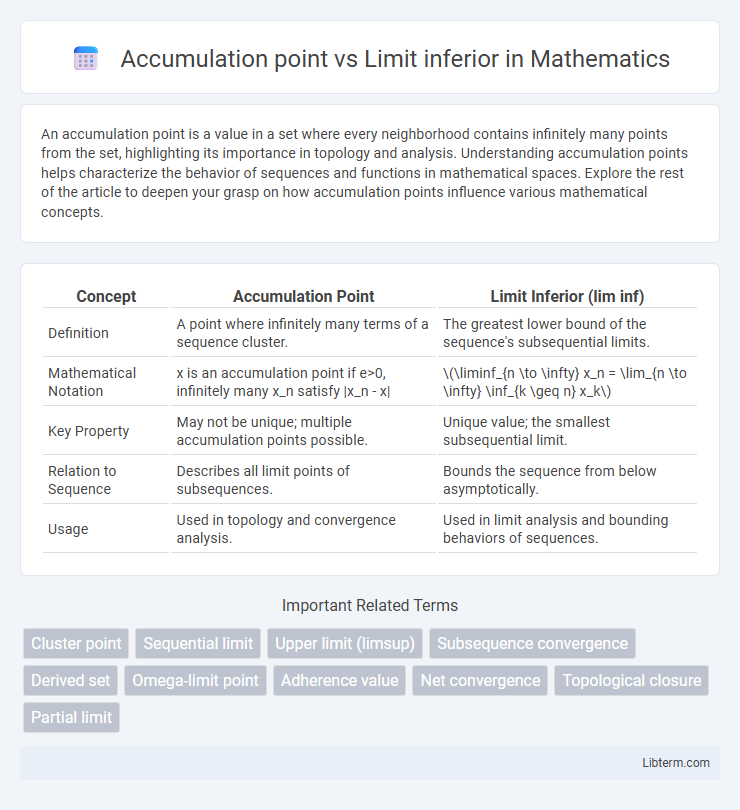An accumulation point is a value in a set where every neighborhood contains infinitely many points from the set, highlighting its importance in topology and analysis. Understanding accumulation points helps characterize the behavior of sequences and functions in mathematical spaces. Explore the rest of the article to deepen your grasp on how accumulation points influence various mathematical concepts.
Table of Comparison
| Concept | Accumulation Point | Limit Inferior (lim inf) |
|---|---|---|
| Definition | A point where infinitely many terms of a sequence cluster. | The greatest lower bound of the sequence's subsequential limits. |
| Mathematical Notation | x is an accumulation point if e>0, infinitely many x_n satisfy |x_n - x|| \(\liminf_{n \to \infty} x_n = \lim_{n \to \infty} \inf_{k \geq n} x_k\) |
|
| Key Property | May not be unique; multiple accumulation points possible. | Unique value; the smallest subsequential limit. |
| Relation to Sequence | Describes all limit points of subsequences. | Bounds the sequence from below asymptotically. |
| Usage | Used in topology and convergence analysis. | Used in limit analysis and bounding behaviors of sequences. |
Introduction to Accumulation Points and Limit Inferior
An accumulation point of a sequence is a value that the sequence approaches infinitely often within any neighborhood, indicating recurring proximity of terms. The limit inferior, or lim inf, represents the greatest lower bound of all subsequential limits, capturing the minimal persistent cluster point. Understanding accumulation points provides insight into the sequence's behavior, while limit inferior quantifies the lowest accumulation behavior over infinite subsequences.
Defining Accumulation Points
An accumulation point of a sequence is a value where every neighborhood contains infinitely many terms of the sequence, representing points that the sequence gets arbitrarily close to infinitely often. Unlike the limit inferior, which is the greatest lower bound of the set of subsequential limits, an accumulation point can be any subsequential limit without the extremal constraint. Defining accumulation points involves identifying all limits of convergent subsequences within the original sequence, capturing the full range of its limiting behavior.
Defining Limit Inferior
Limit inferior, often denoted as lim inf, represents the greatest lower bound of the set of subsequential limits of a sequence, capturing the smallest value that cluster points approach infinitely often. Unlike a general accumulation point, which is any value approached by a subsequence, the limit inferior specifically identifies the "lowest" boundary in the long-term behavior of the sequence. This concept is crucial in real analysis and probability theory for understanding convergence patterns and bounded oscillations of sequences.
Mathematical Formulation: Accumulation Point
An accumulation point of a sequence (x_n) in a metric space is defined as a point x such that every neighborhood of x contains infinitely many terms of the sequence. Formally, x is an accumulation point if for every e > 0, the set {n N : |x_n - x| < e} is infinite. This concept distinguishes accumulation points from limit points, emphasizing the frequency of sequence elements near x rather than mere eventual closeness.
Mathematical Formulation: Limit Inferior
The limit inferior (lim inf) of a sequence \( (x_n) \) is defined as \(\lim_{n \to \infty} \inf_{k \geq n} x_k\), representing the greatest lower bound of the tail sequences. Unlike accumulation points, which are any limit points of subsequences, the limit inferior captures the lowest cluster point that the sequence approaches infinitely often. This formulation ensures the lim inf is always a well-defined extended real number, providing a key tool in analysis for characterizing the sequence's long-term behavior.
Key Differences Between Accumulation Point and Limit Inferior
An accumulation point of a sequence is a value where infinitely many terms of the sequence cluster arbitrarily close, representing a subsequential limit. The limit inferior (lim inf) is the greatest lower bound of the set of all subsequential limits, capturing the smallest value that subsequences approach in the limit. Key differences include that accumulation points can be multiple and scattered, while the limit inferior provides a unique scalar summarizing the minimal boundary of these accumulation points.
Illustrative Examples and Visualizations
An accumulation point of a sequence is a value where infinitely many terms cluster arbitrarily close, whereas the limit inferior represents the greatest lower bound of these accumulation points. For example, in the sequence defined by \(a_n = (-1)^n + \frac{1}{n}\), the accumulation points are 1 and -1, with a limit inferior of -1. Visualizing such sequences on a number line or through graphing reveals how terms approach but do not necessarily converge at accumulation points, highlighting the limit inferior as the lowest boundary among these cluster values.
Applications in Real Analysis
In real analysis, accumulation points identify values where sequences or sets cluster infinitely often, crucial for studying convergence behavior and continuity. Limit inferior provides the greatest lower bound of subsequential limits, essential for understanding oscillation and subsequence convergence properties. Applications include characterizing function limits, analyzing series convergence, and determining compactness in metric spaces.
Common Mistakes and Misconceptions
Confusing accumulation points with limit inferior often leads to errors in sequence analysis, as accumulation points refer to values approached infinitely often, while limit inferior denotes the greatest lower bound of subsequential limits. A common misconception is treating limit inferior as merely the smallest accumulation point, ignoring that it aggregates all smaller limits and captures the sequence's long-term lower behavior. Misidentifying these concepts can cause incorrect conclusions in convergence studies and disrupt precise characterization of sequence behavior in real analysis.
Conclusion and Summary
An accumulation point of a sequence is a value approached infinitely often by its subsequence, while the limit inferior (lim inf) represents the greatest lower bound of all subsequential limits. The limit inferior summarizes the smallest value to which the sequence elements cluster infinitely often, capturing the minimal accumulation behavior. Understanding the distinction clarifies convergence analysis by separating general clustering behavior from the precise minimal limiting value.
Accumulation point Infographic

 libterm.com
libterm.com